According to
legend in 520 AD the Buddhist monk Bodidharma traveled from
India throughout south east Asia finding his
way to the siu lam monastery in China (siu lam is the
Cantonese pronunciation for Shaolin, which is the more
popular mandarin pronunciation) Bodidharma (Taat moh) laid
the foundation for the wing tjun kuen system. In some
wing tjun lineages the birthday of Bodidharma is every day
celebrated.
According to latest research, wing tjun clearly descended from
the southern Shaolin temple. Unlike the story which is most
popular today, which talk about the crane and the fox or the
snake and Buddhist mistress Ng Mui and the lady Yim Wing Chun.
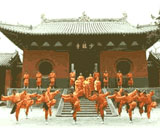 |
Wing Tjun Dim
A special hall was setup in the southern
Shaolin monetary, in which only the most experienced
monks came together in the course of hundreds of
years to refine and improve their Kung Fu. The hall
acquired the name wing tjun dim, which means the
eternal spring hall. |
The philosophy and principle of effectiveness
For the Southern Shaolin monks it was paramount to
experience reality directly. Their philosophy of Chan
Buddhism meant a return to natural and simple
This often stood in contrast to the philosophy of fighting
styles taught outside of the temple. These often referred to
magic fate or obedience of older generations. This is why
the monks of the wing tjun dim incorporated only those
fighting concepts which were really effective, simple and
direct.
Siu Lam Abbot, Chi Sim Sim Si, Guardian of the
Art
Fear and treachery let to the southern
Shaolin
temple being destroyed by the 18th century ruling powers.
The southern Shaolin abbot chi sim, was able to flee with
other monks and got himself hired as a cook on the red boats
under a false name.
The red boats were a favorite place for rebels etc. to hide
and perfect for the rebels for bring information from town
to town as the red boats traveled around to entertain the
people with their Chinese opera.
Tiger Wong
One of the most brutal Kung Fu fighters of his day, Tiger
Wong, tried to extort protection money from the opera
troupes.
He gave them an ultimatum. Should they not pay, then he would destroy their boats. The
leader of the opera troupe Wong Wah Bo and his followers,
were in a state of despair.
They had no money and moreover could not protect themselves,
because they had no real kung fu skill, only the flashy
opera style, which was not effective
for real life confrontations. As the deadline expired, the
members of the red boat felt their end was near.
The Cook
On the day Tiger Wong came to collect. The cook who up till
now, was not taken into consideration and was thought to be
a little crazy, blocked Tiger Wong's path. Tiger Wong did
not take, what seemed to be a cook, seriously and tried to
overcome him quickly. The fight between Tiger Wong and the
abbot Chi Sim, is told by many Wing Tjun families
differently. Certain is that Tiger Wong did not have a
chance against the kung fu of the Wing Tjun Dim.
The vital secret
The members of the red boat, were delighted and wanted to
learn kung fu from their cook at once. Abbot Chi Sim
revealed his true identity and was ready to teach the
members of the opera troupe (this was the first possibility in
history, were the simplification of the system started, as
the members of the opera, certainly didn't had the time that
the monks had in the temple. Creating therefore from the
first set of the Wing Tjun Dim, the Wing Tjun Kuen Set, the
Siu Nim Tau, chum Kiu and Bui Tse by splitting the form in
three parts. An other theory for the creation of these forms
is discussed later and has to do with doctor Leung Jan. Chi
Sim as he was one of the prosecuted man of his time, his
pupils had to promise never to use or reveal his real name.
That is why it came about that many legends concerning Wing
Tjun were invented around this time (for example the story
of Yim Wing Tjun etc.)
So as to protect Master Chi Sim. The first students under
the leadership of Wong Wah Bo, the successor of Chi Sim, were
San Kam, Leung Yee Tai and Leung Laan Kwai.
Only the Wing Tjun masters who learned the entire system
from their master were told the truth.
During the Ching Dynasty serious male artists often portrait
female roles in opera performances as women were not allowed
to perform in public.
San Kam was an excellent artist, who on the one hand was
very good at playing especially female parts in the opera,
but on the other hand represented best of all the Wing Tjun
kuen system in fights at the time (during it's time on the
red boats, the art of the Wing Tjun Dim became known as Wing
Tjun Kuen - Internal Spring Fist, The Kung fu from the
Southern Shaolin Temple) San Kam was his nickname which
meant literarily pretty face.
While San Kam was shopping one day for opera costumes for
the red boat members in Southern China's Fatshan, He was
mocked and attacked by the young
ill tempered tailor apprentice Fung Siu Ching, the bullish
Fung Siu Ching had to land in the dust seven times before he
noticed that he was no match at all for this strange looking
man. Fung Siu Ching wanted to offer tea to San Kam straight
away (Chinese Kung Fu custom in order to become a masters
pupil) Whoever San Kam turned him down on the grounds that
he did not want to teach any ill tempered people.
After Fung Siu Ching have proofed himself to San Kam in a
one year probationary period, he was accepted and introduced
to the art of Wing Tjun Kuen.
Ten years he learned from San Kam, moreover Fung Siu Ching
went on to become one of the most famous Wing Tjun master in
Asia. He was able to transform his
quick temperedness into an endless creative energy for Wing
Tjun.
Fung Siu Ching was one of the only masters to be on the red
boats and in mainland China, he was responsible for the many
different Wing Tjun branches, now spread throughout
Southeast Asia, traveling during his life through countries
like Vietnam and Malaysia. He was also one of the first to
teach Wing Tjun
fulltime. Together with Leung Jan, student of Leung Yee Tai,
he is the most famous historical figure in the history of
Wing Tjun. As many movies and novels
are based on their exploits.
Fung Siu Ching's master pupils in Fatshan were his son Fung
Tin, the Lo brothers, Tang Suen, Dung Yick and the chemist
Ma Chung Yi.
During the Ching Dynasty (1644-1911) only the larger cities,
were protected by the state police of that day.
Small villages were protected by renown kung fu masters.
Master Fung Siu Ching's master pupils guarded many villages
in Fatshan and the surrounding area's. The Lo brothers for
example drove off entire bands of robbers only armed with
their broadswords. On one occasion the Lo brothers are said
to have even chased off 20 armed robbers without severely
injuring them.
Their Wing Tjun Kung Fu brothers Tang Sun received the
honorary title, "King of the Long Pole" from the people from the
villages that he protected, because he kept them safe from
harm using the pole.
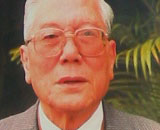 |
Grand Master Wai Yan
Wai Yan was born at the beginning of the
1900's as the son a rich Chinese family in Hong
Kong. Via his older friend Lo Chi Woon, the young
Wai Yan often came into contact with the martial art
Wing Tjun. However Wai Yan, did not really want to
know about kung fu, because he had often experienced
kung fu practitioners as violent and uneducated. |
Had his friend Lo Chi Woon (Student of the Lo brothers) not
being a Wing Tjun Master and a Chinese academic at the same
time Wai Yan would certainly not had any contact with him.
One day Lo Chi Woon asked Wai Yan whether he would teach his
younger son the art of Chinese writing (This is comparable
to accepting the role of godfather in the West) Wai Yan
happily agreed to do so, without being aware of the
consequences his promise he now shared. The responsibility to
the young Lo, conversely this meant for Wai Yan, that he
now also had to master Wing Tjun Kuen, which had been
practiced in the family tradition of the Lo's. In this way
Wai Yan began to learn Wing Tjun from Lo Chi Woon and his
brother Lo Hung Tai around 1930. Wai Yan original dislike of
Kung Fu, changed into an incredible passion and love for the
art of Wing Tjun Kuen. After Wai Yan attained Mastery of
Wing Tjun, he initiated a new project for Wing Tjun to
further refine and research the art.
Dai Duk Lan
Master Wai Yan converted one of his trading houses
called Dai Duk Lan into a Wing Tjun research academy. He did
not want to enroll many pupils in this research academy, but
rather bring together and unite the best Wing Tjun of his
day. These were to research the art together, trained
together and discuss theory, without holding back any
secrets.
The former Shaolin temple served as a model. Shaolin Kung Fu
was developed and tested again and again in the Wing Tjun
hall for more then a thousand years.
The Wing Tjun Masters of Dai Duk Lan
The unbeatable Iron Fist of Wing Tjun
Chu Chung Man:
When Wai Yan heard of an unbeatable Wing Tjun Master called
Chu Chung Man in Macau, he set out straight away to meet
him. He became friends with him after fighting him and being
in awe of his skill. This man was esteemed in Southern
China, because he always defeated every challenger without
much of an effort and also maintained many contacts to other
kung fu masters. Before grandmaster Yip Man's fame, he was
the most famous Wing Tjun master in Hong Kong. Chu Chung Man
was so moved by Wai Yan's project, that he moved to Dai Dak
Lan and accepted the position of chief instructor and leader
of Dai Dak Lan. Chu Chung Man brought to the project his
friend, Wing Tjun master Tam Kong. Tam Kong has specialized
in Kam Naa (grabbing and controlling).
And could beat most opponents there with ease, because many
Kung Fu fighters, did not devote enough attention to
grabbling. Sifu Tam Kong also joint the project.
In Fatshan grandmaster Tang Sun's Wing Tjun Master pupils
Tang Yick and Pak Cheung, where called the King's of the
Long Po Master Pak Cheung was regarded as missing since the
Chinese cultural revolution in 1978 Cheng Kwong found the
old Grandmaster on a remote farm near Fatshan. Shortly before he died on of the teachers of Grandmaster
Sergio Iadarola was able to learn from him.
Sifu Tang Yick was found by Sifu Wai Yan in Hong Kong. At
first Tang Yick did not want to share his knowledge with
other Wing Tjun Masters. However the openness
and warmth of the others changed his mind.
The five dragons of Wing Tjun Kuen
With Sifu Tang Yick the project now
included five
members. Sifu Wai Yan, Sifu Lo Chi Woon, Sifu Chu Chung Man,
Sifu Tam Kong and Sifu Tang Yick.
The Wing Tjun Masters discussed and trained Wing Tjun every
day. They also invited Kung Fu Masters from other styles to
share and exchange there experience.
Also the famous Grand Master Yip Man, teacher of Bruce Lee,
was seen there often during a period of a few years.
The five Wing Tjun Masters where called the "The five
dragons of Wing Tjun Kuen" by the Chinese Kung Fu community.
The project was carried out by Sifu Wai Yan, Chu Chung Man
and Tang Yick for twenty years. The Chief-Instructor and
Grand Master of Dai Duk Lan was Grand Master Chu Chung Man.
Dai Duk Lan was closed in the beginning of 90`s Grand Master
Tang Yick kept on teaching until his death with the help of
Sifu Tang Chung Pak. In the Playing Field
Road in Hong Kong. Grand Master Wai Yan kept on teaching a
few closed door students until his death.
Today all the Grand Masters of the Dai Duk Lan project are
gone. The art lives on in the west through efforts of a few
man like Grand Master Sergio Iadarola, who
learned privately in Hong Kong from the last Master student
of Grand Master Yip Man, Grand Master Leung Ting, his Master
student Allan Fong Wai Hung and learned the Grand Master
Fung Siu Ching lineage through a private student of Grand
Master Wai Yan.
The Leung Jan lineage of Wing Tjun
From Wong Wah Bo on the lineages went separate. One
in the above told story with Wong Wah Bos teaching to San
Gam and one story through Wong Wah Bos teaching to Leung Yee
Tai.
Leung Yee Tai taught Leung Jan who became know in Fatshan as
the "King of Wing Tjun". Through latest research there are
two possibilities for the creation of the most popular part
of the Wing Tjun System consisting of Siu Nim Tau, Chum Kiu
and Biu Tze.
1. This part of the Wing Tjun System was
made by some of the Wing Tjun people on the red boat as
these people simply did not have the time as the monks had
in the Shaolin temple and therefore another method had to be
developed to transmit the Wing Tjun Kuen System. The
solution found was Siu Nim Tau, Chum Kiu and Biu Tze.
2. Dr. Leung Jan was the creator of Siu Nim
Tau, Chum Kiu and Biu Tze. There is historical proof that
Grand Master Leung Jan liked to simplify things. Proof of
that is his creation a few years before his death of Gu Lo
Wing Tjun. Again a simplification of Siu Nim Tau, Chum Kiu
and Biu Tze and putting it all in one curriculum, the Gu Lo
Wing Tjun System named after his native village of Gu Lo
where he went the final years of his life after his
retirement.
What is certain however is that Leung Jan choose to give the
Wing Tjun Part of Siu Nim Tau, Chum Kiu, Biu Tze and
simplified wooden dummy form without footwork to his student
Chan Wah Sun, who in turn was the Sifu of Grand Master Yip
Man. Chan Wah Sun, also known as "Wah the Money Changer" (chau
chin wha) had sixteen students. The last one know being the
nowadays famous Grand Master Yip Man. Who got his fame for a
big part due to being the teacher of famous movie star Bruce
Lee.
Grand Master Yip Man
Yip Man was the second Wing Tjun teacher to teach
Wing Tjun in Hong Kong. The first one being Grand
Master Tang Suen. The big difference however is that
Yip Man was the first one to teach Wing Tjun Kuen in
public. Somewhere around the beginning of the 50`s
Grand Master Yip Man visited the research academy
Dai Duk Lan having a fight with Grand Master Chu
Chung Man. |
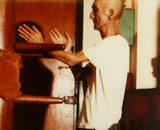 |
According to eye witness accounts the fight was
quickly
over in the favor of Grand Master Chu Chung Man (This is not
to put anything away from the incredible skill of Grand
Master Yip Man its only human, people can loose. Important
to note is Grand Master Yip Man lost from Wing Tjun Kuen,
his own System. He was never beat by another Kung Fu
system).
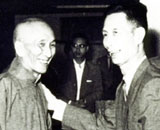 |
GM Yip Man and GM Chu Chung Man
After a long research we can safely say that the
fight between Grand Master Yip Man and the son of
Grand Master Leung Jan, Leung Bik was actually the
fight between Grand Master Yip Man and Grand Master
Chu Chung Man. |
After these incident Grand Master Yip Man went often to Dai
Duk Lan to exchange knowledge and learn more of Wing Tjun
and thus started to improve his system considerably adding
footwork, different kicks and Bart Cham Dao to his Wing Tjun.
Important to note is for example that the Bart Cham Dao form
is only found in the Yip Man System that in whole China all
the other Wing Tjun lineages have other broadsword forms. About the Author:
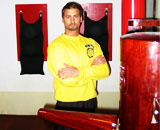
Visit
Grand Master Sergio Iadarola
's website here. |
Grand Master Sergio Iadarola
In Grand Master Sergio Iadarolas opinion all the
variations found today among the different students
of Grand Master Yip Man in their interpretation of
the forms of Wing Tjun Kuen came because the
different periods of time they studied under the
late Grand Master Yip Man and his constant changing
of the things he taught depending what he learned in
Dai Duk Lan.Grand Master Sergio Iadarola is
probably the only one in the
world who says that all the students of Grand Master Yip Man
are right. There are just many variations in Grand Master
Yip Mans teaching through the years he taught. Its sad to
see all the lineages fighting the Wong Shung Leung lineage
putting down the Leung Ting lineage and visa versa etc. Wong
Shun Leung Ving Tsun brought along great fighters and Wing
Tjun Masters as well as the Leung Ting lineage and Leung
Sheung lineage and many more.
Grand Master Sergio Iadarola is one of the only persons in
the world to have had such in-depth study of both latest
period teaching of Grand Master Yip Man plus the
teachings from Dai Duk Lan descending from the teachings of
Fung Siu Ching plus having visited practically every other
Wing Tjun version be taught in Hong Kong during the 90`s. |
|
